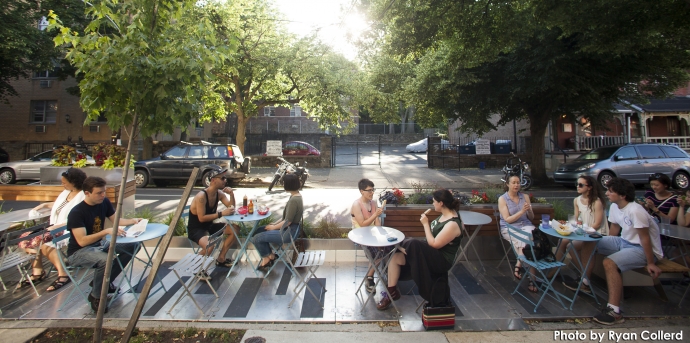
Visitors / Employees
UCD Releases Report on Parklets

We are very happy to share with you the release of our report The Case for Parklets: Measuring the Impact on Sidewalk Vitality and Neighborhood Businesses. In 2011, UCD, working with the City of Philadelphia, installed the city’s first Parklets. These temporary seating platforms created an extension of the sidewalk by replacing one or two parking spaces with a small new park. University City has experimented with the locations and construction of these structures and now places five Parklets near neighborhood businesses each year during the warm season.
The Parklets have been very successful in University City. Seeking to provide both numbers-driven analysis and to serve as a guide for other cities considering turning parking space into temporary parks, UCD’s Department of Planning and Economic Development conducted research on usage patterns for six Parklets, all located on commercial corridors in primarily residential neighborhoods in the University City section of West Philadelphia. From the data, UCD penned the Parklet report, seeking to quantify the Parklets’ ability to attract and retain users, the diversity of the users and uses, the impact on the sales at adjacent businesses, and the micro-scale environmental factors contributing to their success failure.
Key findings from the report included that: Parklets can attract an enormous number of users (well over 150 unique users over the course of a day in the 240 square feet that could otherwise have hosted just one or two parked cars); Parklet installation coincided with a substantial (an average of 20%) boost in sales for nearby businesses; Parklets can have substantial spillover effects to nearby sidewalks and spaces; and Parklet success can be predictable based on a few key environmental factors.
The Case for Parklets: Measuring the Impact on Sidewalk Vitality and Neighborhood Businesses provides data and recommendations based on analyses of six Parklets in University City from the 2013 season and their ability to bring more life to public spaces and more feet to neighborhood businesses. Augmenting the report are 12 pages of full-color charts, graphs, and photos.
- Click here to read the entire report
- Click here for Plan Philly's coverage of the report
- Click here for a brief write-up on Curbed Philly


